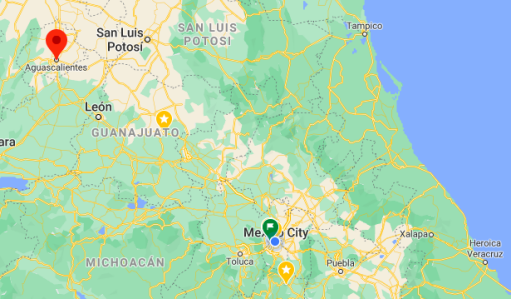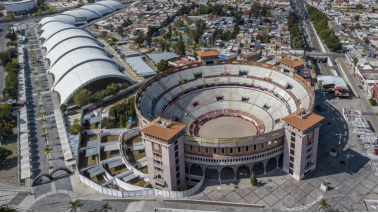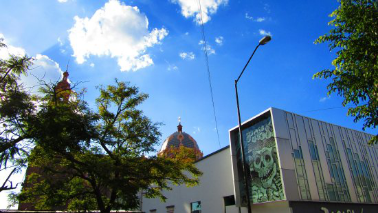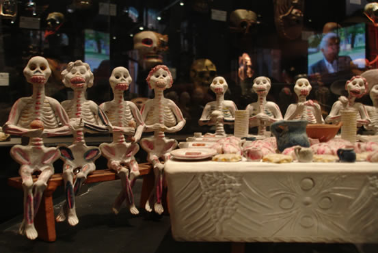Aguascalientes city, Aguascalientes 作者: 来源: 发布时间:2021-03-20
1. Populations and Basic Infomation
Pop: 934,424
Area: 385 km2 (city)
Elev: 1,888 masl
GDP: 11.93 M USD

Aguascalientes location in Mexico within the State of Aguascalientes
https://goo.gl/maps/8hCrvYvfgFyCoVP37
2. Natural geography
As the city of Aguascalientes and the state are located in the Mexican Plateau, along with the states of Guanajuato, Querétaro and parts of Zacatecas, Jalisco and Michoacán; the precipitations are little and they become abundant towards the south. The riverbeds are scarce. The San Pedro River or Aguascalientes River borders the city entering from the north, then surrounds it around the west to move away from the south west, which are joined by the east (now all piped) by the Cedazo and Pirules stream. This first runs below Adolfo López Mateos avenue until it meets the San Pedro River, which is in turn a tributary of the Santiago River. It is without high-flow river currents.
Weather
Köppen Classification: Mid-Latitude Steppe and Desert Climate
This climate type is characterized by extremely variable temperature conditions, with annual means decreasing and annual ranges increasing poleward, and relatively little precipitation. This climate is typically located deep within the interiors of continents and is contiguous with the tropical desert climates of North and South America and of central Asia. This region type owes its origins to locations deep within continental interiors, far from the windward coasts and sources of moist, maritime air. Remoteness from sources of water vapor is enhanced in some regions by mountain barriers upwind.
The Köppen Climate Classification subtype for this climate is "Bsh". (Mid-Latitude Steppe and Desert Climate).
The average temperature for the year in Aguascalientes is 65.3°F (18.5°C). The warmest month, on average, is June with an average temperature of 72.5°F (22.5°C). The coolest month on average is January, with an average temperature of 56.1°F (13.4°C).
The highest recorded temperature in Aguascalientes is 104.0°F (40°C), which was recorded in June. The lowest recorded temperature in Aguascalientes is 19.4°F (-7°C), which was recorded in February.
The average amount of precipitation for the year in Aguascalientes is 20.9" (530.9 mm). The month with the most precipitation on average is July with 4.7" (119.4 mm) of precipitation. The month with the least precipitation on average is March with an average of 0.2" (5.1 mm). In terms of liquid precipitation, there are an average of 64.7 days of rain, with the most rain occurring in July with 13.5 days of rain, and the least rain occurring in March with 1.0 days of rain.
https://www.weatherbase.com/weather/weather-summary.php3?s=981030&cityname=Aguascalientes%2C+Aguascalientes%2C+Mexico&units=
Getting there and around

Get there
By Air – You can fly to Aguascalientes from Dallas in the USA and other points in Mexico including Mexico City and Monterrey. The airport is situated about a 45 minute drive from the center of Aguascalientes on the south side of the city.
By Bus – You can travel to Aguascalientes on a luxury bus from Mexico City— the trip takes 6 hours. An overnight bus runs from Mexico City to Aguascalientes, leaving at around midnight, and arriving in Aguascalientes at 6 am, in time to enjoy the day there.
By Car – Driving to Aguascalientes is very fast and efficient using the many high-speed roads that connect this region.
Car Rental – To explore Mexico’s provincial towns and cities—including its beach locations and the scenery and attractions near them— consider renting a car for your visit. Having your own car will give you more flexibility than using public transport options and, in some cases, offer you access to places which are otherwise difficult to visit without the use of a car.
Get around
Local Buses – Local buses and mini-buses (combis or micros) are available locally for a fraction of the cost of a taxi around town. You need to speak Spanish to be able to ask for directions or ask the driver to tell you where to get off.
Taxis – Taxis in most of Mexico’s towns and cities are not metered, so agree your price before you get in. Taxi travel is very affordable in Mexico, in comparison to the USA, Canada and Europe, and so provides a viable means of public transportation in Mexico. Your hotel can arrange taxis for you; some post their rates on a board in the lobby; taxi hotel rates are usually higher than cabs you hail off the street. If you speak Spanish, you will have a distinct advantage and be able to negotiate a price with the driver.
Uber is expanding rapidly across Mexico and now offers services in cities across the country, including: Mexico City, Toluca, Cuernavaca, Puebla, Querétaro, León, Aguascalientes, San Luis Potosí, Guadalajara, Monterrey, Hermosillo, Tijuana, Mexicali, and Mérida. Uber has been adding Mexican cities to its network every year, check for availability when you arrive at your destination in Mexico.
Cabify is developing also and currently operates in cities including Mexico City, Toluca, Monterrey, Puebla, Querétaro and Tijuana. Check for availability in the city you are visiting.
The services offers people with smartphones a way to book a cab through a mobile app for a pre-agreed price. Fares are comparable with Sitio type cabs (see above), and sometimes trade at a premium to this when local demand increases.
https://www.mexperience.com/transport/taxi-travel-in-mexico/#51
4. Industry
According to the World Bank, Aguascalientes has the most business friendly environment in Mexico and is one of the best places in the world to invest. 240 multinationals were installed during the last 30 years, representing the United States, Japan, Spain, France, Germany, Sweden, and Brazil among others. 70% of Japan's investment in Mexico is in Aguascalientes.
25 companies from the industry of IT & Software cluster. Softtek, the largest software development company in Mexico, has large operations in Aguascalientes.
Aguascalientes is home to two large Nissan manufacturing plants, including the most important outside of Japan. Among other models of cars, they manufacture the Sentra and the Versa. The Aguascalientes plants are responsible for the majority of Mexico's overall annual production of 850,000 Nissan automobiles. Due to their presence, the city has a significant Japanese population.
Texas Instruments has one plant in Aguascalientes, it is dedicated to integrated circuitry (IC) manufacturing. Sensata Technologies, has one plant in the city, making sensors and controls for automotive, HVAC and industrial use. Flextronics is another electronics manufacturer that has a plant located in Aguascalientes City. There are also several companies that work in the robotics industry, the most notable being FANUC Robotics.
Aguascalientes-Guadalajara train project
The governors of the Central-Bajío-Occidente region of Mexico are once again promoting the Aguascalientes-Guadalajara Train project, which was canceled during the previous federal administration. The work is considered a priority to recover the economic dynamics that that area of the country presented until before the pandemic.
The original project requires an investment of 14,165.8 million pesos, according to information from the Ministry of Finance and Public Credit. However, the amount could be higher as the governors are promoting an extension of the line that would take it from the 188.1 km originally planned to more than 200 km.
Originally, the project had 190 km on the route from Encarnación de Díaz to El Castillo, in the municipality of El Salto, in the Guadalajara Metropolitan Area, the new expanded project considers 230 km.
The more than 14 billion pesos that the construction of this infrastructure requires would not be borne by the public budget of the Federation or the states involved. It is envisaged that it could be awarded to a private party who would take charge of its execution and, subsequently, of its operation.
Aguascalientes-Guadalajara, an Interoceanic train
The economic significance of the Aguascalientes-Guadalajara Train project is that it would provide a direct inter-oceanic railroad between the ports of Manzanillo and Altamira, both of great relevance for the country's foreign trade.
The proposed project consists of creating a new railroad that connects the municipality of Encarnación de Díaz with the town of San José el Castillo; This new line will decrease the current journey from 487 km to 188.1 km and will increase the average travel speed from 23 km / h per hour to 56 km / h.
At this time there is no direct railroad between Guadalajara and Aguascalientes. The railway line that today connects both points is diverted to Guanajuato, hence its length is around 500 km, although it could be less than 200 km.
With the new layout, not only would a railway line be obtained in an interoceanic effect, but also safer, as it would bring an increase in the safety and integrity of the cargo, since by not using the Silao-Irapuato road an unsafe area is avoided, due to Because of the low traffic speeds in this section, freight theft is common on trains.
5. Touristic sites
Colonial Center

The center of the city has been excellently preserved and has a great colonial feel and atmosphere about it. The Cathedral in the middle of town is a classic piece of colonial architecture, more so because the second bell tower (the one on the right as you face the Cathedral from the front) is actually a complete modern restoration of the original bell tower.
Don’t miss the Plaza de Toros (Bull Ring) – even if you don’t like bullfighting—the architecture is impressive and a good example of how modern colonial architecture can be blended in with the original works dating back hundreds of years.
https://www.mexperience.com/travel/colonial/aguascalientes
Aguascalientes Cathedral

The place that now occupies the church, there were two chapels, one of them probably built in 1575 and the other built around 1605. The construction of the current temple was began by the priest Antonio Flores Acevedo in 1704 and finished by the priest Manuel Colon de Larreategui in 1738.
The north tower was finished in 1764 and the south in 1946. The diocese of Aguascalientes was established by the Papal Bull, His Holiness Pope Leon XIII, called Apostolic See in 1889.
The image of the Virgin of the Assumption which is in the cypress of the precinct, was brought from Spain to replace the old one in 1919. The cathedral is located in front of the Plaza de la Patria, in the town centre.
There, stands out a beautiful white marble cypress which houses the image of the Virgin of the Assumption, patron saint of the city. In the apse are the chairs of carved wood and the painting of San Juan Nepomuceno. In the central nave is the pulpit with speaker's stand, and a tubular wood organ sticks out from the choir.
http://en.travelbymexico.com/aguascalientes/places-to-visit/?nom=eagscatedral
José Guadalupe Posada Museum

José Guadalupe Posada was born in Aguascalientes on February 2, 1852, was a Mexican engraver, a precursor of the nationalist movement in art and famous for his drawings and engravings on death, whose most famous skulls is La Catrina; they act as ordinary people in everyday Mexican attitudes. Jose Guadalupe Posada Museum is in recognition of the renowned artist. Adjacent to the Temple of Encino, in what was the rectory of the church, spacious hallways and rooms adapted specifically for the exhibition of original works by the engraver that exposed revolutionary themes and the governmental regime of his time.
It consists of three rooms. The first functions as a temporary gallery, in room two, it showcases the work of Manuel Manilla, a contemporary Mexican caricaturist and co-worker of Posada. The main room houses the body of the works of Jose Guadalupe Posada and each year holds a contest dedicated to this character recorded during the months of October and November. It also has a recording studio in which classes are offered for children, youth and adults. Open Tuesday to Sunday from 11:00 a.m. to 6:00 p.m. On Sundays at noon there are cultural events that are held with the participation of independent groups and the Cultural Institute of Aguascalientes. Free admission.
http://en.travelbymexico.com/aguascalientes/places-to-visit/?nom=eagsposada
The Museum of Death

The museum depicts death not as a natural process or as the final end, but as the interpretation and expression of a people in the course of life. The Museum of Death lies in the old cemetery of Santa Veracruz. Neoclassical in style, it was built in a neighborhood of Indians during the 18th century. It retained its status as a cemetery until the year 1866. In 1997 as part of the 34th anniversary of the founding of the Autonomous University of Aguascalientes, it opened its doors to the public as a museum, inviting everyone to know the various artistic manifestations of its peculiar guest; the theme around death from the pre-Hispanic times to the present day. The collection is composed of works donated under the generosity of the master Bajoneras Gil, as well as other pieces amounting to over 2,000 articles related to death. Throughout its seven exhibition rooms housed in two buildings, it addresses the following topics: funeral traditions in Mesoamerican, scared art, crafts, art, and contemporary graphics. You can see the priceless contributions of contemporary artists in the visual arts and graphic arts such as Manuel Manilla, Jose Guadalupe Posada and Francisco Toledo. Every year during the celebrations of the Day of the Dead (November 1 and 2), is an altar dedicated to a different character. It offers guided tours, concerts, conferences, editorial presentations, and workshops of child creativity. Open from Tuesday to Sunday from 10:30a.m. to 6:30p.m. Free admission on Sundays.
http://en.travelbymexico.com/aguascalientes/places-to-visit/?nom=eagsmuerte
AGUASCALIENTES, MEXICO is SO UNDERRATED!!

https://youtu.be/s17j6KOgnL0
6. History and Culture
The city of Aguascalientes was founded on October 22, 1575, by Juan de Montoro as a postal service rest stop between the cities of Zacatecas and Mexico City, though it is known that the site already featured a small population by the time it was granted an official status. Although its founders did not envision it becoming a major city, it became the capital of the newly formed state of the same name when its territory separated from the adjacent state of Zacatecas in 1835. When the state separated from Zacatecas, Aguascalientes raced ahead in its development, while the state of Zacatecas remained behind in comparison.
The historical center of Aguascalientes was born out of four distinct neighborhoods. The oldest of these is the Barrio del Encino, which is technically older than Aguascalientes proper. Founded in 1565 by the Andalusian Hernán González Berrocal, the neighborhood was originally named Triana after the neighborhood in Seville, Spain. The Barrio del Encino is home to the baroque-style Templo del Señor del Encino, a Catholic temple built between 1773 and 1796. The Cristo Negro del Encino ("Black Christ of the live oak"), is a widely venerated religious icon symbolic of this neighborhood. The colonial square and the José Guadalupe Posada Museum, adjacent to the temple, are one of the main attractions in the city.
The second neighborhood is the Barrio de San Marcos, which has its roots in the early 17th century as an indigenous settlement on the outskirts of the then-village of Aguascalientes. Between 1628 and 1688, some communal land was allocated to the community, but the indigenous people still worked on Spanish-owned farms and produced goods to sell in Aguascalientes. Meanwhile, they organized the construction of a simple hospital and a chapel. This original chapel was replaced by the current Templo de San Marcos completed on December 15, 1763; this church is the spiritual headquarters of the Feria Nacional de San Marcos.
The third neighborhood is the Barrio de Guadalupe, which began its development as a string of shops and trading posts alongside the road leading from Aguascalientes to Jalpa and Zacatecas during the latter half of the 18th century. The neighborhood's iconic Templo de Guadalupe was built between 1767 and 1789; it's recognized for its Spanish Baroque façade and its dome lined with Talavera tiles. Especially after the founding of the Fundición Central Mexicana ("Mexican Central Foundry"), the neighborhood developed quickly; by the early 20th century its roadside inns had mostly been converted into homes and its boundaries had blurred with those of the Barrio de San Marcos.
The final neighborhood is the Barrio de la Salud, which has its roots in a small chapel and a cemetery developed towards the end of the 18th century to deal with a number of disease epidemics that had struck the area. Gravediggers established homes near the cemetery, and others took advantage of the open land to establish orchards. Though the orchards began to disappear during the early 20th century, clues as to the neighborhood's roots still remain. First of all, the fact that property lines generally followed irrigation ditches can still be seen in the neighborhood's haphazard street grids today. Second, the neighborhood's working-class character is visible in its primarily single-story homes featuring simple façades.
A fifth neighborhood, the Barrio de la Estación, is often grouped in with the city's original neighborhoods. However, this neighborhood is considerably more modern, with much of its development dating from the final decades of the 19th century or later. Therefore, despite its important role in the history of Aguascalientes, it's not strictly accurate to consider the Barrio de la Estación one of the city's original historical neighborhoods.
7. Contact Information
City Mayor: María Teresa Jiménez Esquivel

Contact number: +52 (449) 910 1010
Govt. Office Address: Plaza Patria S/N, Zona Centro, Aguascalientes, Ags. CP. 20000
FB: https://www.facebook.com/TereJimenezAgs
Twitter: https://twitter.com/TereJimenezE
Website: https://www.ags.gob.mx
